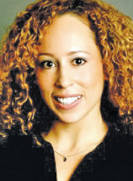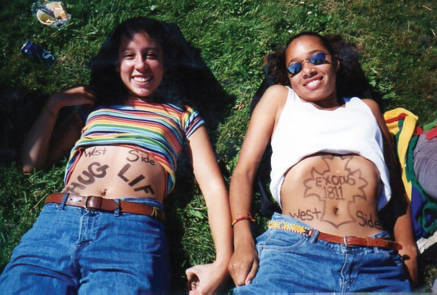Jenée Desmond-Harris, Tupac and My Non-Thug Life
| Jenée Desmond-Harris | Tupac and My Non-thug Life |

JENÉE DESMOND-HARRIS is a staff writer at the Root, an online magazine dedicated to African American news and culture. She writes about the intersection of race, politics, and culture in a variety of formats, including personal essays. She has also contributed to Time magazine, MSNBC’s Powerwall, and xoJane on topics ranging from her relationship with her grandmother, to the political significance of Michelle Obama’s hair, to the stereotypes that hinder giving to black-teen mentoring programs. She has provided television commentary on CNN, MSNBC, and Current TV. Desmond-Harris is a graduate of Howard University and Harvard Law School. The following selection was published in the Root in 2011. It chronicles Desmond-Harris’s reaction to the murder of gangsta rap icon Tupac Shakur in a Las Vegas drive-by shooting in 1996. She mentions Tupac’s mother, Afeni, as well as the “East Coast–West Coast war”—the rivalry between Tupac and the Notorious B.I.G. (Biggie), who was suspected of being involved in Tupac’s murder.
As you read, consider the photograph that appeared in the Root article and that is reproduced here:
- What does it capture about the fifteen-year-old Desmond-Harris?
- What does its inclusion say about Desmond-Harris’s perspective on her adolescent self and the event she recollects?
1I learned about Tupac’s death when I got home from cheerleading practice that Friday afternoon in September 1996. I was a sophomore in high school in Mill Valley, Calif. I remember trotting up my apartment building’s stairs, physically tired but buzzing with the frenetic energy and possibilities for change that accompany fall and a new school year. I’d been cautiously allowing myself to think during the walk home about a topic that felt frighteningly taboo (at least in my world, where discussion of race was avoided as delicately as obesity or mental illness): what it meant to be biracial and on the school’s mostly white cheerleading team instead of the mostly black dance team. I remember acknowledging, to the sound of an 8-count that still pounded in my head as I walked through the door, that I didn’t really have a choice: I could memorize a series of stiff and precise motions but couldn’t actually dance.
2My private musings on identity and belonging—not original in the least, but novel to me—were interrupted when my mom heard me slam the front door and drop my bags: “Your friend died!” she called out from another room. Confused silence. “You know, that rapper you and Thea love so much!”
Mourning a Death in Vegas
3The news was turned on, with coverage of the deadly Vegas shooting. Phone calls were made. Ultimately my best friend, Thea, and I were left to our own 15-year-old devices to mourn that weekend. Her mother and stepfather were out of town. Their expansive, million-dollar home was perched on a hillside less than an hour from Tupac’s former stomping grounds in Oakland and Marin City. Of course, her home was also worlds away from both places.
4We couldn’t “pour out” much alcohol undetected for a libation, so we limited ourselves to doing somber shots of liqueur from a well-stocked cabinet. One each. Tipsy, in a high-ceilinged kitchen surrounded by hardwood floors and Zen flower arrangements, we baked cookies for his mother. We packed them up to ship to Afeni with a handmade card. (“Did we really do that?” I asked Thea this week. I wanted to ensure that this story, which people who know me now find hilarious, hadn’t morphed into some sort of personal urban legend over the past 15 years. “Yes,” she said. “We put them in a lovely tin.”)
5On a sound system that echoed through speakers perched discreetly throughout the airy house, we played “Life Goes On” on a loop and sobbed. We analyzed lyrics for premonitions of the tragedy. We, of course, cursed Biggie. Who knew that the East Coast–West Coast war had two earnest soldiers in flannel pajamas, lying on a king-size bed decorated with pink toe shoes that dangled from one of its posts? There, we studied our pictures of Tupac and re-created his tattoos on each other’s body with a Sharpie. I got “Thug Life” on my stomach. I gave Thea “Exodus 1811” inside a giant cross. Both are flanked by “West Side.”
6A snapshot taken that Monday on our high school’s front lawn (seen here) shows the two of us lying side by side, shirts lifted to display the tributes in black marker. Despite our best efforts, it’s the innocent, bubbly lettering of notes passed in class and of poster boards made for social studies presentations. My hair has recently been straightened with my first (and last) relaxer and a Gold ’N Hot flatiron on too high a setting. Hers is slicked back with the mixture of Herbal Essences and Blue Magic that we formulated in a bathroom laboratory.

7My rainbow-striped tee and her white wifebeater capture a transition between our skater-inspired Salvation Army shopping phase and the next one, during which we’d wear the same jeans slung from our hip bones, revealing peeks of flat stomach, but transforming ourselves from Alternative Nation to MTV Jams imitators. We would get bubble coats in primary colors that Christmas and start using silver eyeliner, trying—and failing—to look something like Aaliyah.1
Mixed Identities: Tupac and Me
8Did we take ourselves seriously? Did we feel a real stake in the life of this “hard-core” gangsta rapper, and a real loss in his death? We did, even though we were two mixed-race girls raised by our white moms in a privileged community where we could easily rattle off the names of the small handful of other kids in town who also had one black parent: Sienna. Rashea. Brandon. Aaron. Sudan. Akio. Lauren. Alicia. Even though the most subversive thing we did was make prank calls. Even though we hadn’t yet met our first boyfriends, and Shock G’s proclamations about putting satin on people’s panties sent us into absolute giggling fits. And even though we’d been so delicately cared for, nurtured and protected from any of life’s hard edges—with special efforts made to shield us from those involving race—that we sometimes felt ready to explode with boredom. Or maybe because of all that.
9I mourned Tupac’s death then, and continue to mourn him now, because his music represents the years when I was both forced and privileged to confront what it meant to be black. That time, like his music, was about exploring the contradictory textures of this identity: The ambience and indulgence of the fun side, as in “California Love” and “Picture Me Rollin’.” But also the burdensome anxiety and outright anger—“Brenda’s Got a Baby,” “Changes” and “Hit ’Em Up.”
10For Thea and me, his songs were the musical score to our transition to high school, where there emerged a vague, lunchtime geography to race: White kids perched on a sloping green lawn and the benches above it. Below, black kids sat on a wall outside the gym. The bottom of the hill beckoned. Thea, more outgoing, with more admirers among the boys, stepped down boldly, and I followed timidly. Our formal invitations came in the form of unsolicited hall passes to go to Black Student Union meetings during free periods. We were assigned to recite Maya Angelou’s “Phenomenal Woman” at the Black History Month assembly.
11Tupac was the literal sound track when our school’s basketball team would come charging onto the court, and our ragtag group of cheerleaders kicked furiously to “Toss It Up” in a humid gymnasium. Those were the games when we might breathlessly join the dance team after our cheer during time-outs if they did the single “African step” we’d mastered for BSU performances.
Everything Black—and Cool
12. . . Blackness became something cool, something to which we had brand-new access. We flaunted it, buying Kwanzaa candles and insisting on celebrating privately (really, just lighting the candles and excluding our friends) at a sleepover. We memorized “I Get Around”2 and took turns singing verses to each other as we drove through Marin County suburbs in Thea’s green Toyota station wagon. Because he was with us through all of this, we were in love with Tupac and wanted to embody him. On Halloween, Thea donned a bald cap and a do-rag, penciled in her already-full eyebrows and was a dead ringer.
13Tupac’s music, while full of social commentary (and now even on the Vatican’s playlist), probably wasn’t made to be a treatise on racial identity. Surely it wasn’t created to accompany two girls (little girls, really) as they embarked on a coming-of-age journey. But it was there for us when we desperately needed it.
1A hit rhythm-and-blues and hip-hop recording artist. Aaliyah Dana Haughton died in a plane crash at age twenty-two. [Editor’s note]
2Tupac Shakur’s first top-twenty single, released in 1993 on Strictly 4 My N.I.G.G.A.Z., Shakur’s second studio album. [Editor’s note]